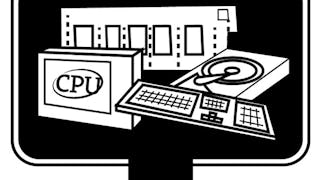The basis for education in the last millennium was “reading, writing, and arithmetic;” now it is reading, writing, and computing. Learning to program is an essential part of the education of every student, not just in the sciences and engineering, but in the arts, social sciences, and humanities, as well. Beyond direct applications, it is the first step in understanding the nature of computer science’s undeniable impact on the modern world. This course covers the first half of our book Computer Science: An Interdisciplinary Approach (the second half is covered in our Coursera course Computer Science: Algorithms, Theory, and Machines). Our intent is to teach programming to those who need or want to learn it, in a scientific context.



(1,267 reviews)
Skills you'll gain
Details to know
10 assignments
See how employees at top companies are mastering in-demand skills

There are 10 modules in this course
Why program? This lecture addresses that basic question. Then it describes the anatomy of your first program and the process of developing a program in Java using either virtual terminals or a program development environment, with some historical context. Most of the lecture is devoted to a thorough coverage of Java's built-in data types, with example programs for each.
What's included
4 videos2 readings1 assignment1 programming assignment
The if, while, and for statements are Java's fundamental control structures. This lecture is built around short programs that use these constructs to address important computational tasks. Examples include sorting, computing the square root, factoring, and simulating a random process. The lecture concludes with a detailed example illustrating the process of debugging a program.
What's included
5 videos2 readings1 assignment1 programming assignment
Computing with a large sequence of values of the same type is extremely common. This lecture describes Java's built-in array data structure that supports such applications, with several examples, including shuffling a deck of cards, the coupon collector test for randomness, and random walks in a grid.
What's included
3 videos2 readings1 assignment1 programming assignment
To interact with our programs, we need mechanisms for taking information from the outside world and for presenting information to the outside world. This lecture describes several such mechanisms: for text, drawings, and animation. Detailed examples covered include fractal drawings that model natural phenomena and an animation of a ball bouncing around in the display window.
What's included
4 videos2 readings1 assignment1 programming assignment
Modular programming is the art and science of breaking a program into pieces that can be individually developed. This lecture introduces functions (Java methods), a fundamental mechanism that enables modular programming. Motivating examples include functions for the classic Gaussian distribution and an application that creates digital music.
What's included
4 videos2 readings1 assignment1 programming assignment
A recursive function is one that calls itself. This lecture introduces the concept by treating in detail the ruler function and (related) classic examples, including the Towers of Hanoi puzzle, the H-tree, and simple models of the real world based on recursion. We show a common pitfall in the use of recursion, and a simple way to avoid it, which introduces a different (related) programming paradigm known as dynamic programming.
What's included
5 videos2 readings1 assignment1 programming assignment
When you develop a program, you need to be aware of its resource requirements. In this lecture, we describe a scientific approach to understanding performance, where we develop mathematical models describing the running time our programs and then run empirical tests to validate them. Eventually we come to a simple and effective approach that you can use to predict the running time of your own programs that involve significant amounts of computation.
What's included
5 videos2 readings1 assignment1 programming assignment
In Java, you can create your own data types and use them in your programs. In this and the next lecture, we show how this ability allows us to view our programs as abstract representations of real-world concepts. First we show the mechanics of writing client programs that use data types. Our examples involve abstractions such as color, images, and genes. This style of programming is known as object-oriented programming because our programs manipulate objects, which hold data type values.
What's included
4 videos2 readings1 assignment1 programming assignment
Creating your own data types is the central activity in modern Java programming. This lecture covers the mechanics (instance variables, constructors, instance methods, and test clients) and then develops several examples, culminating in a program that uses a quintessential mathematical abstraction (complex numbers) to create visual representations of the famous Mandelbrot set.
What's included
4 videos2 readings1 assignment1 programming assignment
We conclude the course with an overview of important issues surrounding programming languages. To convince you that your knowledge of Java will enable you to learn other programming languages, we show implementations of a typical program in C, C++, Python, and Matlab. We describe important differences among these languages and address fundamental issues, such as garbage collection, type checking, object oriented programming, and functional programming with some brief historical context.
What's included
5 videos1 reading1 assignment1 programming assignment
Instructors


Offered by
Recommended if you're interested in Software Development


Duke University


University of London


Princeton University


University of London
Why people choose Coursera for their career




Learner reviews
1,267 reviews
- 5 stars
83.20%
- 4 stars
11.27%
- 3 stars
2.12%
- 2 stars
1.10%
- 1 star
2.28%
Showing 3 of 1267
Reviewed on Jun 15, 2021
Can't wait to get into the second part of the course. The best programming course ever provided for free of cost. The techniques used are backed by mathematical thinking. It is just awesome.
Reviewed on Aug 29, 2020
Fantastic course with a strong focus on assignments.Very helpful regardless of programming experience. The professor is very nice and provides key insights.
Reviewed on Jul 23, 2020
Really fun and challenging exercises! Had a great time solving them. The book site a lot more interesting problems and students should check it out.
New to Software Development? Start here.

Open new doors with Coursera Plus
Unlimited access to 10,000+ world-class courses, hands-on projects, and job-ready certificate programs - all included in your subscription
Advance your career with an online degree
Earn a degree from world-class universities - 100% online
Join over 3,400 global companies that choose Coursera for Business
Upskill your employees to excel in the digital economy
Frequently asked questions
Once you enroll, you’ll have access to all videos and programming assignments.
No. The lecture videos, exercises, and programming assignments are all available for free.
No. As per Princeton University policy, no certificates, credentials, or reports are awarded in connection with this course.

